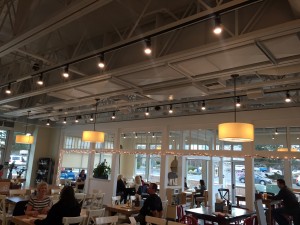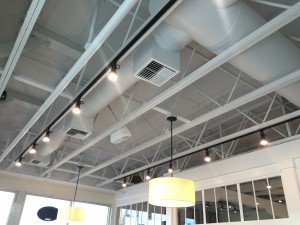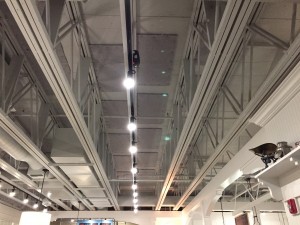Managing Restaurant Noise at Jackson’s Corner
Restaurant consumers were recently asked, “How do you feel about restaurant noise?” Of the 1,232 responses, nearly 80% said, “Loathe it.” (About 14% said they don’t notice noise, and about 7% love it.) Echoing numerous restaurant reviewers around the country, one participant commented, “The most consistent complaint I hear from friends and readers has to do with noisy restaurants.” It’s a common cry, one that has reached the pinnacle of customer dissatisfaction in the Zagat Dining Trends Survey. Diners around the country now rank noise in restaurants as their #1 complaint.
Today’s Project Highlight from 2015 is Jackson’s Corner Eastside location. I was asked to provide a proposal of cost to help this popular but noisy restaurant. “The customers are up and leaving, complaining they can’t carry on a conversation” described Palmer Noble, a Jackson’s Corner Manager. I was one of two people they asked to help them but I was chosen for one primary reason, which I am going to reveal at the end of the post. Keep reading…
Now, I’d like to share the process and focus your attention regarding what to consider when thinking about solving sound issues.
First, Observe.
• How is the space being used?
• What obstacles are in the way such as pillars, exposed beams, sprinkler heads, etc.?
• Identify the hard surfaces like concrete, windows, and wood.
Second, Listen.
• What is going on in the room and outside of the building? Identify the floor volume. If you just listen, you’ll find a pretty long list of persistent “noise” like fans, espresso machine, ice machine, buzzing neon signs, etc.
• Where is the sound traveling mostly? Vertically or Horizontally? From the ceiling?
Third. Remember that Beautiful Design + Great Acoustics = Sound Design
• Consider the environment, the look, the feel; don’t make it ugly.
• Discuss color that will blend in or be visually creative. Locate color swatches or color numbers to match the proposed acoustic treatment colors.
• Consider mounting methods and the use of adhesive, grommets and wire, or staples.



Next, here are two key terms to understand and apply:
1. Sound Reverberation – the persistence of sound in an enclosed space after the source of the sound has stopped. The level of the reverberant sound within a room is dependent on both the volume of the room and the amount of sound absorption installed within the room, such that small hard surfaced rooms are “louder” than large well-treated rooms.
2. Sound Reflection – the Intentional use of non-absorptive surfaces that enhance a lively acoustical sound quality, typically for night clubs or music venues.
OK now for the answer: What was the primary reason I was chosen to do this job for Jackson’s Corner Eastside? I brought the right tools with me: a Sound Level Meter and a Laser Measuring devise. Wink!
See you at Jackson’s!


